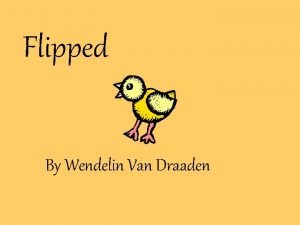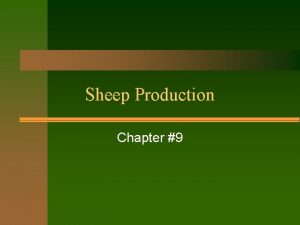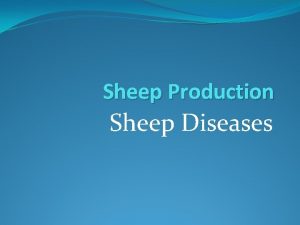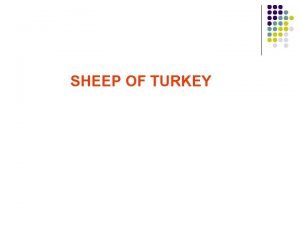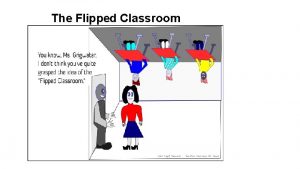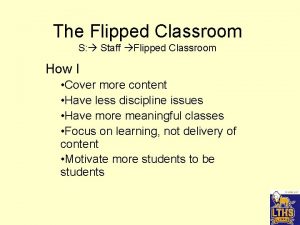Sheep Production Flipped classroom week 13 Why choose


















- Slides: 18

Sheep Production Flipped classroom – week 13

Why choose sheep? Sheep can survive where cows can’t n Sheep will eat problem weeds like Leafy Spurge n Profit per acre is the same for sheep and cows, and usually higher for sheep n Easier to get started due to less equipment needed n

Classes of Sheep Producers Rancher – plain states, pasture in abundance, sell lambs for feeders, large # of ewes n Farm Flock – (small numbers), sell finished lambs, try for fall & winter lambs n Lamb Feeder – located in grain belt n Purebred Breeder – requires more skill and high investment n

Breed Categories Wool Type: white wool only, better quality n Meat Type: any black wool n Dual Purpose: white wool, but better meat than wool types n

Feeding Sheep Mostly roughages, concentrates for finishing n Average adult eats about 4 lbs. . . dry feed per day n Overfat ewes - problems conceiving & delivering n

Feeding Sheep If sheep can eat all their feed in 1/2 hour, increase amount n If food left at next feeding, decrease amount n Average lamb weighs 7 -9 lbs. . . and will gain 1/2 LB per day n Flush ewes 17 days prior to breeding (increased level of nutrition) n

Feeding Sheep Increase nutrition 6 weeks prior to lambing until 1 -2 months after lambing n Increase quality of feed not quantity – stomachs shrink when pregnant due to lambs in uterus n Males - increase nutrition 6 weeks prior to breeding to build strength n

Sheep Reproduction Seasonal breeders - only breed in spring and fall n Ewe lambs must be 100 lbs. . . to breed n Ram can service 12 -15 ewes as a lamb, and up to 100 as a yearling n Most common = 3 rams / 100 ewes n Usually not kept after 6 yrs n

Sheep Reproduction Marking harness - ram marks back of ewe with a crayon when mating n Change crayon colors every couple of weeks, if ewes are rebred, the first time was not successful – may have a bad ram or ewe n

Lambing Many lambs are lost in the first 24 hrs n Twins - first born gets separated while second is being born n Assist difficult lambings n Disinfect hands, gently pull front legs n Give ewe antibiotics after n Disinfect lambs navel with iodine n

Lambing Lamb should nurse within minutes, especially if cold weather n Strip teats to remove a mucous plug that seals the teat, lamb may not be strong enough to suck the plug out and not get any milk, if he fails, he will quit trying and die n

Lambing Colostrum: mothers first milk (antibiotics) n Keep ewe and lamb together for first 24 hours or more if the ewe doesn’t want to claim the lamb n Grafting: adopting lambs (triplets) onto other ewes (with singles or dead lambs) – cam be difficult to get ewe to claim lamb n

Management Identification: mark lambs with paint brands, or ear tags or tattoo ears (purebreds) n Docking: cut off tails – tails are a bother – between 1 st and 2 nd vertebrae of tail – Elastrator: rubber band cuts off circulation – Hot Iron: electric, heated knife stops bleeding n

Management Castration: remove testicles – Elastrator – Cut with a knife – Burdizzo crushes cords n Dock & Castrate before 6 weeks old n Wean at 5 -6 months or 100 lbs. . . n Shear at least once per year, before lambing (20 -40% of income) n

Management Culling: choosing animals not to keep for breeding purposes n Aging Sheep: less than 1 yr. . = milk teeth – 1 -2 yrs = middle two teeth replaced by 2 larger teeth – each year to 4 yrs = another set replaced – 6 -7 yrs = begin to lose teeth (broken n

Sheep Terms What do you call an adult male? Ram or Buck n What do you call an adult female? Ewe n What do you call the act of giving birth? Lambing n

Sheep Terms What do you call a castrated male? Wether n What is the gestation for sheep? 147 days n What do you call a young female? Ewe Lamb n

 Paola seregni
Paola seregni Flipped learning advantages and disadvantages
Flipped learning advantages and disadvantages Venitemi dietro con l'occhio significato
Venitemi dietro con l'occhio significato Meg moodle
Meg moodle Didattica capovolta
Didattica capovolta Bioengineering flipped classroom
Bioengineering flipped classroom Flipped classroom
Flipped classroom Flipped classroom examples
Flipped classroom examples Flipped classroom pros and cons
Flipped classroom pros and cons Acrostic poem of english
Acrostic poem of english 3 proses produksi multimedia
3 proses produksi multimedia Hey hey bye bye
Hey hey bye bye Week by week plans for documenting children's development
Week by week plans for documenting children's development Cse smart class
Cse smart class 7. choose the correct item
7. choose the correct item Choose the corect answer
Choose the corect answer Flipped book setting
Flipped book setting Flipped advising
Flipped advising Flipped up their noses like goats
Flipped up their noses like goats
















